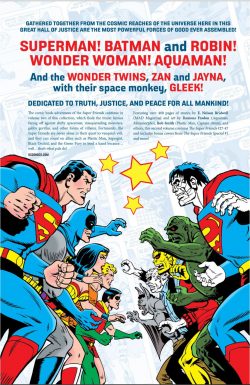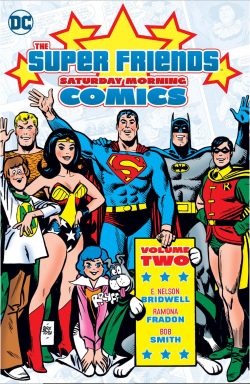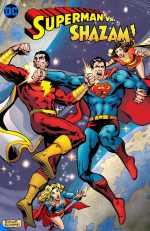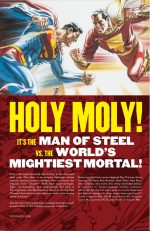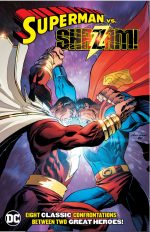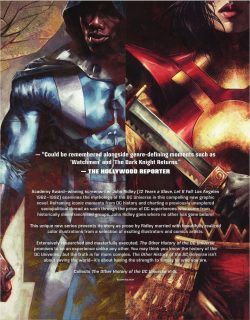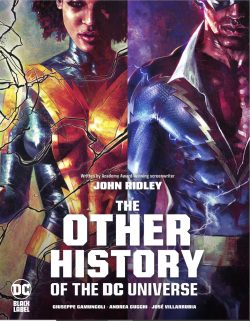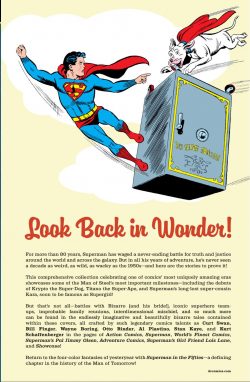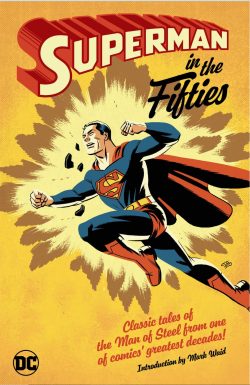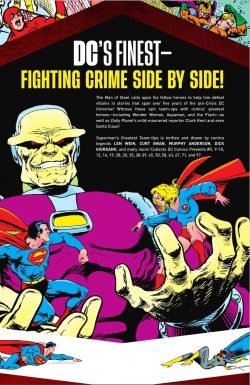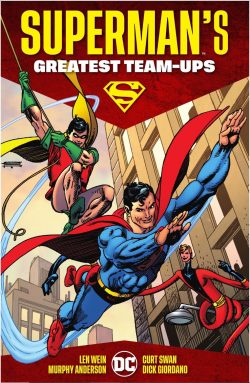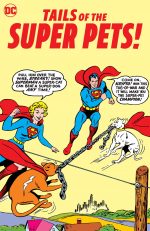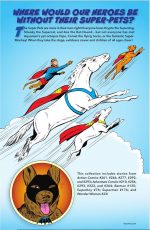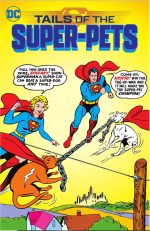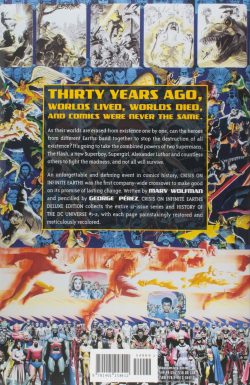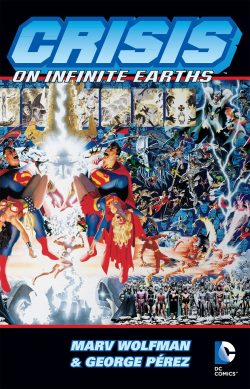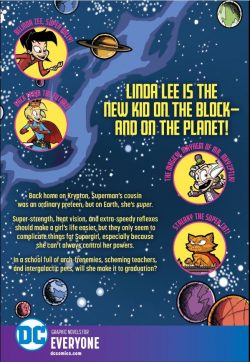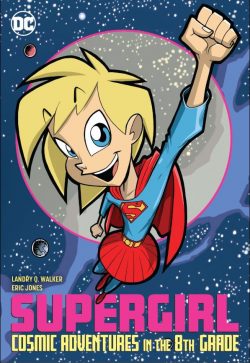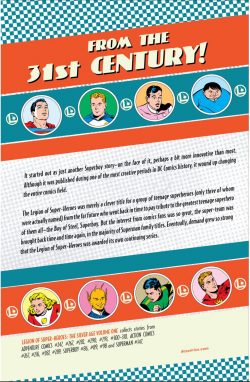
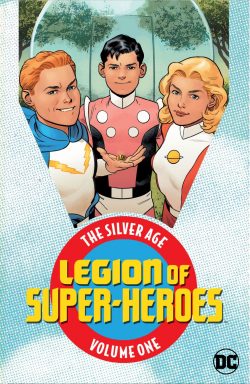
By Otto Binder, Jerry Siegel, Edmond Hamilton, Robert Bernstein, Al Plastino, George Papp, Jim Mooney, Curt Swan, John Forte & various (DC Comics)
ISBN: 978-1-4012-8157-1 (TPB/Digital edition)
Once upon a time, in the far future, a super-powered kids from dozens of alien civilisations took inspiration from the greatest legend of all time and formed a club of heroes. One day those Children of Tomorrow came back in time and invited that legend to join them…
And thus began the vast and epic saga of the Legion of Super-Heroes, as first envisioned by writer Otto Binder & artist Al Plastino in early 1958, just as the revived comic book genre of superheroes was gathering an inexorable head of steam. Since that time the fortunes and popularity of the Legion have perpetually waxed and waned, with their future history tweaked and rebooted, retconned and overwritten again and again to comply with editorial diktat and popular whim.
This glorious, far-and-wide ranging collection assembles the numerous preliminary appearances of the valiant Tomorrow People and their inevitable progress towards and attainment of their own feature. It includes all pertinent material from Adventure Comics #247, 267, 282, 290, 293, and 300-310, Action Comics #267, 276, 287, 289, Superboy #86, 89, 98 and Superman #147, cumulatively spanning April 1958 through July 1963.
Happy anniversary!
The many-handed mob of juvenile universe-savers eponymously premiered in Adventure Comics #247 (cover-dated April 1958) in Superboy tale ‘The Legion of Super-Heroes!’ wherein three mysterious kids invited the Boy of Steel to the 30th century to join a club of metahuman champions inspired by his life.
Devised by Otto Binder & Al Plastino, the throwaway concept gripped public imagination and, after frequent further appearances throughout Superman Family titles, the LSH eventually took over the Boy of Steel’s lead spot in Adventure for their own far-flung, quirky escapades, with the Caped Kid Kryptonian reduced to merely “one of the in-crowd”…
However, here the excitement is still gradually building as the kids return 18 months later in Adventure #267 (December 1959) for Jerry Siegel & George Papp to play with. In ‘Prisoner of the Super-Heroes!’ the teen wonders attack and incarcerate the Boy of Steel because of a misunderstood ancient record they have uncovered…
The following summer Supergirl met the Legion in Action Comics #267 (August 1960, by Siegel & Jim Mooney) as Lightning Lad, Saturn Girl and Cosmic Boy secretly travel to “modern day” America and invite the Maid of Might to join the team, in a repetition of their offer to Superboy 15 years previously (in nit-picking fact they claimed to be the children of the original team – a fact glossed over and forgotten these days: don’t time-travel stories make your head hurt?).
Due to a dubious technicality, young and overeager Kara Zor-El fails her initiation task at the hands of ‘The Three Super-Heroes’ and is asked to reapply later – but at least we get to meet a few more Legionnaires, including Chameleon Boy, Invisible Kid and Colossal Boy…
With editors still cautiously testing the waters, it was Superboy #86 (cover-dated January 1961 but on sale in November 1960) before ‘The Army of Living Kryptonite Men!’ (by Siegel & Papp) turned the LSH into a last-minute Deus ex Machina to save the Smallville Sentinel from juvenile delinquent Lex Luthor’s most insidious assault.
Two months later in Adventure #282, Binder & Papp introduced Star Boy as a romantic rival for the Krypton Kid in ‘Lana Lang and the Legion of Super-Heroes!’…
For Action #276 (May 1961) Siegel & Mooney debuted ‘Supergirl’s Three Super Girl-Friends’, which finally saw her crack the plasti-glass ceiling and join the team, sponsored by Saturn Girl, Phantom Girl and Triplicate Girl. We also met for the first time Bouncing Boy, Shrinking Violet, Sun Boy and potential bad-boy love-interest Brainiac 5 (well, at least his distant ancestor Brainiac was a very bad boy…)
Next comes a pivotal tale as ‘Superboy’s Big Brother’ (by Robert Bernstein & Papp from Superboy #89, June 1961) reveals how an amnesiac, super-powered space traveller crashes in Smallville, speaking Kryptonese and carrying star-maps written by the Boy of Steel’s long-dead father…
Jubilant, baffled and suspicious in equal amounts, Superboy eventually, tragically discovers ‘The Secret of Mon-El’ after accidentally exposing the stranger to a lingering, inexorable death, before providing critical life-support by desperately depositing the dying alien in the timeless Phantom Zone until a cure can be found…
With an August 1961 cover-date Superman #147 unleashed ‘The Legion of Super-Villains!’ (Siegel, Curt Swan & Sheldon Moldoff): a stand-out thriller featuring the adult Luthor and correspondingly mature wicked future bad guys coming far too close to destroying the Action Ace …until the temporal cavalry arrives…
Bernstein & Papp seemingly give Sun Boy a starring role in ‘The Secret of the Seventh Super-Hero!’ (Adventure #290, November 1961), followed by a clever tale of redemptive second chances followed in #293 (February 1962) in a gripping thriller from Siegel, Swan & George Klein. ‘The Legion of Super-Traitors’ posits the future heroes turning evil, prompting Saturn Girl to recruit a Legion of Super-Pets including Krypto, Streaky the Super Cat, Beppo, the monkey from Krypton and magical Superhorse Comet to save the world…
Siegel & Mooney set ‘Supergirl’s Greatest Challenge!’ in Action #287 (April 1962) seeing her visit the Legion (quibblers be warned: for some reason it was mis-determined as the 21st century in this story) to save future Earth from invasion. She also met a telepathic descendent of her cat Streaky. His name was Whizzy (I could have omitted that fact but chose not to – once again for smug, comedic effect and in sympathetic solidarity with cat owners everywhere…)
Action #289 originally hosted ‘Superman’s Super-Courtship!’ wherein the Girl of Steel scours the universe for an ideal mate for her cousin. One highly possible candidate is the adult Saturn Woman, but for some reason her husband Lightning Man objects…
Modern sensibilities might quail at the conclusion but at that time his obvious perfect match was a doppelganger of Supergirl herself… albeit thankfully a little bit older…
By the release of Superboy #98 (July 1962), the decision had been made. The buying public wanted more Legion stories and after ‘The Boy with Ultra-Powers’ (Siegel, Swan & Klein) introduced a mysterious lad with greater powers than the Boy of Steel, focus shifted to Adventure Comics where #300 (cover-dated September 1962) proudly saw the futuristic super-squad finally land their own gig: even occasionally taking an alternating cover-spot from the still top-featured Boy of Steel.
Tales of the Legion of Super-Heroes opened its stellar run with ‘The Face Behind the Lead Mask!’ by Siegel, John Forte & Plastino: a fast-paced premier pitting Superboy and the 30th century champions against an impossibly unbeatable foe until Mon-El, long-trapped in the Phantom Zone, briefly escapes a millennium of confinement to save the day…
In those halcyon days humour was as important as action, imagination and drama, so many early exploits were light-hearted and moralistic. Adventure #301 offered hope to fat kids everywhere with ‘The Secret Origin of Bouncing Boy!’ by regular creative team Siegel & Forte, wherein the process of open auditions was instigated.
These provided fans with dozens of truly bizarre and memorable applicants over the years but here allows the rebounding human rotunda to deliver a salutary pep talk and inspirational account of heroism persevering to triumph over adversity.
Adventure #302 featured ‘Sun Boy’s Lost Power!’ with the golden boy forced to resign until fortune and boldness restore his abilities, after which ‘The Fantastic Spy!’ in #303 sparks a tense tale of espionage and potential betrayal by new member Matter-Eater Lad.
The happy readership was stunned by the events of #304 when Saturn Girl engineered ‘The Stolen Super-Powers!’ to make herself a one-woman Legion. Of course, it was for the best possible reasons, but still didn’t prevent the shocking murder of Lightning Lad…
As a result she was elected Legion leader – at that time the first female to ever lead a comic book team.
With comfortable complacency utterly destroyed, #305 further shook everything up with ‘The Secret of the Mystery Legionnaire!’ who turns out to be long-suffering Mon-El, finally cured and freed from his Phantom Zone prison.
Normally I’d try to be more obscure about story details – after all my intention is to get new people reading old comics – but these “spoiler” revelations are crucial to further understanding here and besides you all know these characters are still around, don’t you?
Pulp sci fi author Edmond Hamilton took over the major scripting role with Adventure #306, introducing ‘The Legion of Substitute Heroes!’ (still quirkily, perfectly illustrated by John Forte): a group of rejected audition applicants selflessly banding together and clandestinely assisting the champions who had spurned them, after which transmuting orphan Element Lad joins the big league.
He seeks vengeance upon the space pirates who had wiped out his entire species in ‘The Secret Power of the Mystery Super-Hero!’ whilst in #308 readers seemingly saw ‘The Return of Lightning Lad!’
Actual Spoiler Warning: skip to the next paragraph NOW!!!
Otherwise you’ll find out it was actually his similarly empowered sister who – once unmasked and unmanned – took her brother’s place as Lightning Lass…
Penultimate escapade ‘The Legion of Super-Monsters!’ was a straightforward clash with embittered applicant Jungle King who took his rejection far too personally and gathered a deadly clutch of space beasts to wreak havoc and vengeance, after which the future tension temporarily subsides with ‘The Doom of the Super-Heroes!’ from #310: a frantic battle for survival against an impossible foe
The Legion is undoubtedly one of the most beloved and bewildering creations in American comic book history and largely responsible for the growth of the groundswell movement that became Comics Fandom.
Moreover, these sparkling, simplistic and devastatingly addictive stories, as much as the legendary Julie Schwartz Justice League, fired up the interest and imaginations of a generation of young readers and built the industry we all know today.
These naive, silly, joyous, stirring and utterly compelling yarns are precious and fun beyond any ability to explain – even if we old lags gently mock them to ourselves and one another. If you love comics and haven’t read this stuff, you are the poorer for it and need to enrich your future life as soon as possible.
© 1958-1963, 2018 DC Comics. All Rights Reserved.

